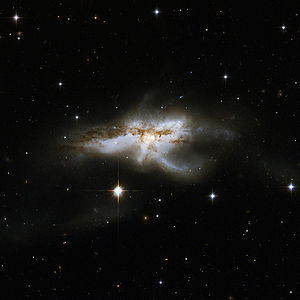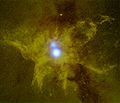NGC 6240
| Galaxy NGC 6240 |
|
|---|---|

|
|
| Photo from the Hubble Space Telescope | |
| AladinLite | |
| Constellation | Snake bearer |
|
Position equinox : J2000.0 , epoch : J2000.0 |
|
| Right ascension | 16 h 52 m 58.9 s |
| declination | + 02 ° 24 ′ 03 ″ |
| Appearance | |
| Morphological type | I0: / pec / LINER / Sy2 |
| Brightness (visual) | 12.8 mag |
| Brightness (B-band) | 13.8 mag |
| Angular expansion | 2 ′, 1 × 1 ′, 0 |
| Position angle | 20 ° |
| Surface brightness | 13.7 mag / arcmin² |
| Physical data | |
| Redshift | 0.024480 ± 0.000030 |
| Radial velocity | 7339 ± 9 km / s |
|
Stroke distance v rad / H 0 |
(332 ± 23) x 10 6 ly (101.7 ± 7.1) Mpc |
| history | |
| discovery | Édouard Jean-Marie Stephan |
| Discovery date | July 12, 1871 |
| Catalog names | |
| NGC 6240 • IC 4625 • UGC 10592 • PGC 59186 • CGCG 025-011 • MCG + 00-43-004 • IRAS 16504 + 0228 • 2MASX J16525886 + 0224035 • VV 617 • GC 5833 • PRC D-28 | |
NGC 6240 is an irregular galaxy of the Hubble type I0: in the constellation Serpent Bearer north of the celestial equator . It is approximately 332 million light-years from the Milky Way , 300,000 light-years in diameter, and is listed as a Seyfert-2 galaxy .
particularities
What is unusual about this galaxy is that, according to current knowledge, there are three active black holes in its core , which have come together in the new galaxy core due to collisions of three smaller galaxies that are still in progress . Each of the three black holes has more than 90 million solar masses . They emit a large amount of X-rays and circle around each other at intervals of 3,000 light years until they will merge in a few hundred million years. The fact that several galaxies also merge at the same time provides a possible explanation of how the largest galaxies with their central, supermassive black holes can develop much faster.
Since the collision of the original galaxies only occurred around 30 million years ago, NGC 6240 shows itself to be a typical starburst galaxy . Because of the relative permeability of the dust in the galaxy to the infrared light of the young stars , NGC 6240 is an ultra- luminous infrared galaxy (ULIRG) that can be easily observed with the Spitzer infrared telescope .
photos
Center of the galaxy NGC 6240 in visible light, overlaid with X-rays from the Chandra telescope
The object was discovered on July 12, 1871 by the French astronomer Édouard Jean-Marie Stephan .
Web links
- Do black holes dance? from the alpha-Centauri television series(approx. 15 minutes). First broadcast on Jan 21, 2004.
- Chandra X-Ray Observatory
- Dissertation University of Hamburg, 2006
- astronews: Picture of the day May 19, 2015


